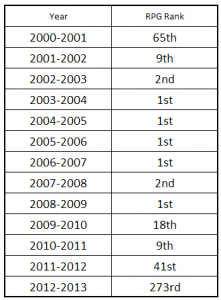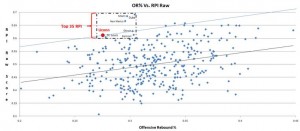Outliers – a Statistical Analysis
Please note: this post was written by OkaForPrez:
Before you read the rest of this blog entry, I want you to stop and think about the signature aspect of UConn basketball in the Jim Calhoun era.
Undoubtedly, some of you have pictured the full court pressure, run and gun teams of the early 90’s. Maybe you are imagining Donny Marshall streaking behind the defense on the receiving end of a 25 yard strike from Doron Sheffer immediately after a made basket.
If you are like me and were on campus in 2004, or any year between 2002 and 2009, you probably thought of the intimidating defense of Block-Shot-U. Incredibly, UConn lead the country in blocks every year during this period before finally relinquishing the title to Marshall in 2010. The Huskies finished 2nd in blocks that year.
I’m willing to bet that most of you have defined UConn by the parade of special wings that have come through the program over the years. It’s hard to not settle on Ray, or Rip, or Rudy.
But I wonder how many of you thought about rebounding? Since 2000, UConn has finished outside the top 20 in the country in rebounds per game twice. They were 65th in the country in ’00-’01 and 41st in 2011-2012. Every other year in that window they were among the country’s best rebounding teams, and often the best. But rebounding by its nature is not glamorous. We take it for granted and what it means to the success of all great college basketball teams. That is we did until this season of course. Kevin Ollie’s UConn Huskies are on pace to finish 273rd out of 347 Division I teams in rebounds per game.
 As a fan base, we have certainly been humbled by the rebounding gods, but not surprised. We said goodbye to Alex, for better and worse. We collectively had the wind knocked out of us when Roscoe followed him to the exits. We’ve watched Andre do incredible things; in Detroit. In October, we all looked down at the roster to see Tyler and Niels, Deandre and Enosch. This has been a slow train coming. So while #273 is a staggering number, we’ve all been bracing. And yet here in late February we are surprised, because despite the absence of the unexciting yet essential backbone of UConn Basketball for decades, the team has continued to win.
As a fan base, we have certainly been humbled by the rebounding gods, but not surprised. We said goodbye to Alex, for better and worse. We collectively had the wind knocked out of us when Roscoe followed him to the exits. We’ve watched Andre do incredible things; in Detroit. In October, we all looked down at the roster to see Tyler and Niels, Deandre and Enosch. This has been a slow train coming. So while #273 is a staggering number, we’ve all been bracing. And yet here in late February we are surprised, because despite the absence of the unexciting yet essential backbone of UConn Basketball for decades, the team has continued to win.
One of Ken Pomeroy’s four essential factors for predicting success on the basketball court is offensive rebound percentage. Simply put, it’s how many of your own misses do you pull down. I decided to plot this statistic vs. RPI raw scores as of Friday the 22nd of February to see just how UConn’s success stacks up against the rest of the country relative to their woeful rebounding. What I found is that only 7 schools deviate from the trend line of Offensive Rebound % vs. RPI more than UConn does. This is to say only 2% of college basketball teams are winning more than their ability to offensively rebound suggests they should be able to.
Equally as interesting, only 7 of the top 35 schools in the RPI rebound less than 32% of their own misses. These schools are Duke, Miami, New Mexico, Georgetown, Belmont, St. Louis and UConn. Taking a look at these teams in more detail can help us understand what they (and we) are doing to overcome this deficiency.
The quickest way to make up for your opponent’s outrebounding you is to take much better care of the basketball than they do. The seven schools above turn the ball over 1.5 to 4 times less than their opponents. UConn specifically forces 2.3 more turnovers per game than they commit. The joys of an upperclassman point-guard! One more year Bazz.
Another way to minimize the impact of not being able to gather your misses is not to miss in the first place. Duke, for example, has an effective field goal percentage that is 8.8% better than its opponents’. The Blue Devils achieve that by shooting a staggering 12% better from 3. While not nearly as impressive, UConn’s 6% effective FG % advantage has helped its cause. UConn’s next opponent, Georgetown, also enjoys a significant shooting advantage at +9.4% vs. its opponents. The Hoyas do so by assisting on 7.3% more of their baskets. John Thompson III’s slow down, Princeton-style offense is for real, as is Otto Porter. UConn has a tall order in Gampel on Wednesday.
New Mexico overcomes a lot of its rebounding deficiencies by getting to the line a lot more than its opponents. The Lobos’ free-throw rate, or the number of free throws made relative to the number of field goals attempted is 20% higher than their opponents. That number is incredible! The Lobos are shooting 5% better than their opponents at the charity stripe – and they get their much more often. I can’t tell if this helps or hurts their cause in March. Will it make them consistent or will it hurt them if they catch a crew who swallows their whistles? UConn also capitalizes on a 5% advantage in FT shooting relative to its opponents and a 6% advantage in its free throw rate. For not having much of an interior game, the Huskies certainly know how to draw contact.
Stepping back to look at the rebound-soft 7, it becomes pretty clear that if you want to succeed despite a drastic rebounding disadvantage, you’d better be exceptional at one of the following, or good at them all: Getting to the line and making your free-throws, protecting the basketball, and shooting the ball. This year, UConn has overcome its diminished frontcourt by doing all three well. After all is said and done, you won’t lose many games shooting 70% in the 2nd half like the Huskies did against DePaul. So while this version of the Huskies may not be the quintessential version of the 2000’s, they are rebounding from a lot more despite rebounding a lot less.

